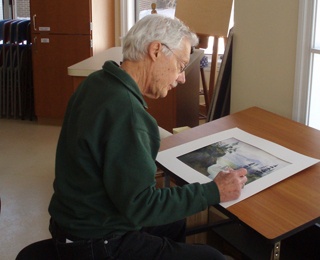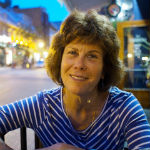Published: April 7, 2016
 “I don’t have a creative bone in my body.”
“I don’t have a creative bone in my body.”
Bet you know someone (maybe the face in the mirror?) who has voiced this sentiment, or carries it around like a talisman.
“Balderdash!” says best-selling author Elizabeth Gilbert, who challenges Ted Talk listeners to replace the word “creative” with “curious.”
“If you can just release yourself from the anxiety and burden that might be associated with the word ‘creativity,’ because you’ve fallen for the myth that it only belongs to the special, the tormented and the professional, and you insert the word “curious,” you’ll see, in fact, that you are an enormously creative person, because all creativity begins with curiosity,” Elizabeth says.
That’s good news for curious, older adults living in retirement communities. Creative opportunities abound, plus they are full of residents and staff excited to help others learn to paint, make pottery, take photographs and more.
Express Yourself
Many residents are surprised to find a calendar full of creative activities when they move into their new home in a life plan community. From art studios to writing circles, today’s communities have opportunities and outlets for people at all levels of talent and interest.
For instance, Kendal at Oberlin residents publish Eureka!, a literary and creative arts journal, make furniture and other items in a Woodshop and attend concerts and art shows on their campus. They even have a group of residents who put together fresh flower arrangements for community spaces and special events.
The North Hollywood Senior Arts Colony in California has a fully equipped theater and painting and sculpture studios. Other communities offer clay classes, chorus participation and poetry writing and appreciation workshops.
Creative and art activities are campus-wide at Kendal and other continuing care retirement communities, and adapted so residents at all levels of ability and health can participate.
Music and art therapists provide activities for assisted and skilled nursing residents to sing and play chime bells, paint, color and create other visual arts, and dance and engage in other movements.
Field Trips and Cultural Caravans
Another benefit to living in a retirement community is the easy access to off-campus sites, such as museums, concerts and plays. Many communities provide transportation, often at no additional cost, to such activities and centers in a certain geographic area.
For communities located in a city that is also home to a college or university, cultural and creative opportunities are plentiful. Oberlin College’s Conservatory of Music students, faculty and visiting musicians perform nearly 500 concerts on campus each year, many which are free. The college also operates the Allen Memorial Art Museum.
Residents living at Holy Cross Village at Notre Dame in Indiana are tour guides at the Basilica of Sacred Heart on the campus.
Audit classes, library access and other perks are common at these communities.
"Current retirees are very focused on active, intellectually stimulating and intergenerational retirement environments, which is exactly what a college campus has to offer," says assistant professor Andrew Carle, executive-in-residence and founding director of the Program in Senior Housing Administration at George Mason University.
And since these retirement communities attract artists, musicians, professors and other accomplished professionals, other residents have opportunities to learn and create alongside them.
Creativity is Good Medicine
In the Creativity and Aging study spearheaded by the late Dr. Gene Cohen, seniors who participated in intensive, participatory arts and lifelong learning programs had improved health, fewer doctor visits and less medication usage.
"There is no denying the problems that accompany aging. But what has been universally denied is the potential. The ultimate expression of potential is creativity," said Dr. Gene Cohen, author of “The Creative Age: Awakening Human Potential in the Second Half of Life.”
Susan Perlstein, with the National Center for Creative Aging who worked with Dr. Cohen, said new research proves that creativity has many benefits for aging adults, including improvements in their mastery and control, social engagement and immune systems.
 Molly Kavanaugh frequently wrote about Kendal at Oberlin for the Cleveland Plain Dealer, where she was a reporter for 16 years.
Molly Kavanaugh frequently wrote about Kendal at Oberlin for the Cleveland Plain Dealer, where she was a reporter for 16 years.





